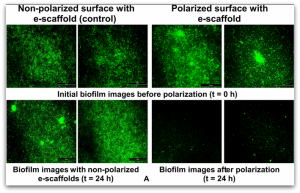
The electric current was able to kill almost all drug resistant bacterium within 24 hours.
Image: Nature
A new alternative to traditional antibiotics is on the horizon. Through the application of electrical stimulation, researchers from Washington State University have found a way to kill drug resistant bacterium without the need for antibiotics.
“We have been doing fundamental research on this for many years, and finally, we are able to transfer it to technology,’’ says Haluk Beyenal, ECS member and co-author of the study. “It’s really exciting.’’
While these results are groundbreaking for biomedical science, the idea of treating infection through electrical stimulation is not new. Researchers have been attempting to do this for years, but have not been able to perfect the method.
Because of this, antibiotics have become the most effective and preferred treatment choice for infections. However, as antibiotic use increases, the bacteria being treated begin to adapt. Drug resistant strains then begin to form, which infect at least two million people a year in the United States alone. From those two million, about 23,000 people die annually as a direct result. With this, researchers see the need to find an alternative form of treatment for bacterial infection.
ICYMI: Listen to Alvin Salkind talk about electrochemistry’s biomedical applications.
One reason that electrical stimulation has had mixed results over the years is due to the lack of understanding of how the process works electrochemically.
This from Washington State University:
The WSU researchers for the first time demonstrated the electrochemical reaction produces hydrogen peroxide, an effective disinfectant, at the electrode surface. [They] optimized the reaction and developed an “e-scaffold,” a sort of electronic Band-Aid made out of conductive carbon fabric. By running electrical current through the fabric, they produced a low and constant concentration of hydrogen peroxide to kill the bugs. The bacteria are unable to develop resistance to such an electrochemical treatment.
“Many people tried this simple method,’’ says Beyenal. “Sometimes it worked, and sometimes it didn’t. We controlled the electrochemical reactions. That’s the reason it works.’’

